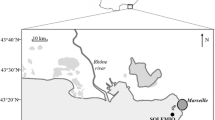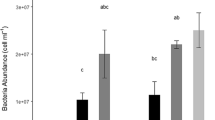Abstract
We collected benthic bacterial production data measured by 3H thymidine incorporation (TTI) (25 studies), frequency of dividing cells (FDC) (3 studies), dark-C02 assimilation (1 study) and 3H-adenine uptake (2 studies) from the literature, which included 18 marine, 6 river, and 2 lake studies. In all of the studies that used the TTI method, 3H-DNA was isolated and incubations were carried out at in situ temperatures. Most of the researchers also determined 3H-DNA extraction efficiencies and isotope dilution, thus interpretable estimates of bacterial production were used in the analysis. In marine sediments, bacterial production rates were linked to bacterial biomass, bacterial abundance, sediment organic matter, temperature, and sediment chlorophyll a, with these variables explaining between 40% and 68% of the variation in production rates. Simple relationships between production and bacterial biomass or bacterial abundance, or between production and sediment organic matter, were improved by also including temperature in the analysis of marine sediments. Sediment organic matter explained an appreciable fraction (58%) of the observed production in freshwater sediments. Temperature was the most powerful predictor of the observed variability in specific growth rates (r 2 = 0.48 and r 2 = 0.58) in marine and freshwater sediments, respectively. Thus, bacterial production and specific growth rates are most closely linked to substrate supply and temperature in marine and freshwater sediments.
Similar content being viewed by others
References
Alongi DM (1988) Bacterial productivity and microbial biomass in tropical mangrove sediments. Mar Ecol 15:59–79
Alongi DM (1988) Microbial-meiofaunal interrelationships in some tropical intertidal sediments. J Mar Res 46:349–365
Alongi DM, Boto KG, Tirendi F (1989) Effect of exported mangrove litter on bacterial productivity and dissolved organic carbon fluxes in adjacent tropical nearshore sediments. Mar Ecol Prog Ser 56:133–144
Austin HK, Findlay S (1989) Benthic bacterial biomass and production in the Hudson River Estuary. Microb Ecol 18:105–116
Bell RT, Ahlgren I (1987) Thymidine incorporation and microbial respiration in the surface sediment of a hypereutrophic lake. Limnol Oceanogr 32:476–482
Bird DF, Duarte C (1989) Bacteria-organic matter relationship in sediments: a case of spurious correlation. Can J Fish Aquat Sci 46:904–908
Bostrøm B, Pettersson A, Ahlgren I (1989) Seasonal dynamics of a cyanobacteria-dominated microbial community in surface sediments of a shallow, eutrophic lake. Aquat Sci 51:153–178
Boto KG, Alongi DM, Nott ALI (1989) Dissolved organic carbon-bacteria interactions at sediment-water interface in a tropical mangrove system. Mar Ecol Prog Ser 51:243–251
Bratbak G, Dundas I (1984) Bacterial dry matter content and biomass estimations. Appl Environ Microbiol 48:755–757
Brittain AM, Karl DM (1990) Catabolism of tritiated thymidine by aquatic microbial communities and incorporation of tritium into RNA and protein. Appl Environ Microbiol 56:1245–1254
Cammen LM (1991) Annual bacterial production in relation to benthic microalgal production and sediment oxygen uptake in an intertidal sandflat and an intertidal mudflat. Mar Ecol Prog Ser 71:13–25
Chocair JA, Albright LJ (1981) Heterotrophic activity of bacterioplankton and bacteriobenthos. Can J Microbiol 27:259–266
Cole JJ, Findlay S, Pace ML (1988) Bacterial production in freshwater and saltwater ecosystems: a cross-system overview. Mar Ecol Prog Ser 43:1–10
Craven DB, Jahnke RA, Carlucci AF (1986) Fine-scale vertical distributions of microbial biomass and activity in California Borderland sediments. Deep-Sea Res 33:379–390
Duarte C, Bird DF, Kalff J (1988) Submerged macrophytes and sediment bacteria in the littoral zone of Lake Memphremagog (Canada). Verh Int Verein Limnol 23:271–281
Fallon RD, Boylen CW (1990) Bacterial production in freshwater sediments: cell specific versus system measures. Microb Ecol 19:53–62
Fallon RD, Newell SY, Hopkinson CS (1983) Bacterial production in marine systems: will cell-specific measures agree with whole-system metabolism? Mar Ecol Prog Ser 11:119–127
Fenchel T, Blackburn TH (1979) Bacteria and mineral cycling. Academic Press, New York
Findlay SEG, Meyer JL, Edwards RT (1984) Measuring bacterial production via rate of incorporation of 3H thymidine into DNA. J Microbiol Methods 2:57–72
Findlay SEG, Meyer JL, Risley R (1986) Benthic bacterial biomass and production in two blackwater rivers. Can J Fish Aquat Sci 43:1271–1276
Fuhrman JA, Azam F (1980) Bacterioplankton secondary production estimates for coastal waters of British Columbia, Antarctica, and California. Appl Environ Microbiol 39:1085–1095
Gilmour CC, Leavitt ME, Shiaris MP (1990) Evidence against incorporation of exogenous thymidine by sulphate-reducing bacteria. Limnol Oceanogr 35:1401–1409
Hakanson L, Jansson M (1983) Principles of lake sedimentology. Springer-Verlag, Heidelberg
Hansen FA, Alongi DM, Moriarty DJW, Pollard PC (1987) The dynamics of benthic microbial communities at Davies Reef, central Great Barrier Reef. Coral Reefs 6:63–70
Hobbie JE (1988) A comparison of the ecology of planktonic bacteria in fresh and salt water. Limnol Oceanogr 33(4):750–764
Iriberri J, Muela A, Egea L (1985) Heterotrophic bacterial activity in coastal waters: functional relationship of temperature and phytoplankton production. Ecol Models 28:113–120
Johnson RK, Bostrøm B, van de Bund W (1989) Interactions between Chironomus plumosus (L.) and the microbial community in surficial sediments of a shallow, eutrophic lake. Limnol Oceanogr 34:992–1003
Johnstone BH, Jones RD (1989) A study on the lack of [methy-3H] thymidine uptake and incorporation by chemolithotrophic bacteria. Mar Ecol Prog Ser 18:73–77
Jones JG (1982) Activities of aerobic and anaerobic bacteria in lake sediments and their effect on the water column. In: Newell DB, Brown CM (eds) Sediment microbiology. Academic Press, New York, pp 107–145
Kaplan LA, Bott TL (1989) Diel fluctuations in bacterial activity on streambed substrata during vernal algal blooms: effects of temperature, water chemistry, and habitat. Limnol Oceanogr 34:718–733
Kaplan LA, Bott TL, Bielicki JK (1992) Assessment of [3H] thymidine incorporation into DNA as a method to determine bacterial productivity in stream bed sediments. Appl Environ Microbiol 58:3614–3621
Kelly LA, Chynoweth DP (1981) The contributions of temperature and of the input of organic matter in controlling rates of sediment methanogenesis. Limnol Oceanogr 26:891–897
Kemp PF (1987) Potential impact on bacteria of grazing by a macrofaunal deposit-feeder, and the fate of bacterial production. Mar Ecol Prog Ser 36:151–161
Kemp PF (1988) Bacterivory by benthic ciliates: significance as a carbon source and impact on sediment bacteria. Mar Ecol Prog Ser 49:163–169
Kemp PF (1990) The fate of benthic bacterial production. Rev Aquat Sci 2:109–124
Li WKW, Dickie PM (1987) Temperature characteristics of photosynthetic and heterotrophic activities: seasonal variations in temperate microbial plankton. Appl Environ Microbiol 53:2282–2295
Lorenz MG, Aardema BW, Krumbein WE (1981) Interaction of marine sediment with DNA and DNA availability to nucleases. Mar Biol 64:417–420
McDonough RJ, Sanders RW, Porter KG, Kirchman DL (1986) Depth distribution of bacterial production in a stratified lake with an anoxic hypolimnion. Appl Environ Microbiol 52:992–1000
Meyer JL (1988) Benthic bacterial biomass and production in a blackwater river. Verb Int Verein Limnol 23:1832–1838
Meyer-Reil LA (1983) Benthic response to sedimentation events during autumn to spring at a shallow water station in the western Kiel Bight. II. Analysis of benthic bacterial populations. Mar Biol 77:247–256
Meyer-Reil L, Dawson R, Liebezeit G, Tiedge H (1978) Fluctuations and interactions of bacterial activity in sandy beach sediments and overlying waters. Mar Biol 48:161–171
Moriarty DJW (1986) Bacterial productivity in ponds used for culture of Penaeid Prawns. Microb Ecol 12:259–269
Moriarty DJW (1990) Techniques for estimating bacterial growth rates and production of biomass in aquatic environments. Methods Microbiol 22:211–234
Moriarty DJW, Hansen JA (1990) Productivity and growth rates of coral reef bacteria on hard calcareous substrates and in sandy sediments in summer. Aust J Mar Fresh Res 41:785–794
Moriarty DJW, Pollard PC (1981) DNA synthesis as a measure of bacterial productivity in seagrass sediments. Mar Ecol Prog Ser 5:151–156
Moriarty DJW, Pollard PC (1990) Effects of radioactive labelling of macromolecules, disturbance of bacteria, and adsorption of thymidine to sediment on the determination of bacterial growth rates in sediment with tritiated thymidine. J Microbiol Methods 11:127–139
Moriarty DJW, Boon PI, Hansen JA, Hunt WG, Poiner IR, Pollard PC, Skyring GW, White DC (1985) Microbial biomass and productivity in seagrass beds. Geomicrobiol J 4:21–51
Newell SY, Fallon RD (1982) Bacterial productivity in the water column and sediments of the Georgia (USA) coastal zone: Estimates via direct counting and parallel measurement of thymidine incorporation. Microb Ecol 8:33–46
Novitsky JA (1983) Microbial activity at the sediment-water interface in Halifax Harbor, Canada. Appl Environ Microbiol 45:1761–1766
Novitsky JA (1990) Evidence for sedimenting particles as the origin of the microbial community in a coastal marine sediment. Mar Ecol Prog Ser 60:161–167
Pollard PC, Moriarty DJW (1984) Validity of the tritiated thymidine method for estimating bacterial growth: measurement of isotope dilution during DNA synthesis. Appl Environ Microbiol 48:1076–1083
Pollard PC, Moriarty DJW (1991) Organic carbon decomposition, primary and bacterial productivity, and sulphate reduction in tropical seagrass beds of the Gulf of Carpentaria, Australia. Mar Ecol Prog Ser 69:149–159
Pomeroy LR, Deibel D (1986) Temperature regulation of bacterial activity during the spring bloom in Newfoundland coastal waters. Science 233:159–161
Pomeroy LR, Wiebe WJ (1988) Energetics of microbial food webs. Hydrobiologia 159:7–18
Psenner R (1990) From image analysis to chemical analysis of bacteria: a long term study. Limnol Oceanogr 35:234–236
Ricker WE (1973) Linear regressions in fishery research. J Fish Res Board Can 30:409–434
Riemann B, Bjornsen PK, Newell S, Fallon R (1987) Calculation of cell production of coastal marine bacteria based on measured incorporation of 3H thymidine. Limnol Oceanogr 32:471–476
Rowan D, Kalff J, Rasmussen J (1992) Profundal sediment organic content and physical character do not reflect lake trophic status, but rather reflect inorganic sedimentation and exposure. Can J Fish Aquat Sci 49:1431–1438
Schallenberg M, Kalff J (1993) The ecology of sediment bacteria in lakes and comparisons with other aquatic ecosystems. Ecology 74:919–934
Sherr EB, Sherr BF (1991) Planktonic microbes: tiny cells at the base of the ocean's food webs. Trends Ecol Evol 6:50–54
Sorokin YI (1978) Microbial production in the coral-reef community. Arch Hydrobiol 83:281–323
Sprugel DG (1983) Correcting for bias in log-transformed allometric equations. Ecology 64:209–210
Suess E (1980) Particulate organic carbon flux in the oceans: surface productivity and oxygen utilization. Nature 288:260–263
van Duyl FC, Kop AJ (1990) Seasonal patterns of bacterial production and biomass in intertidal sediments of the western Dutch Wadden Sea. Mar Ecol Prog Ser 59:249–261
van Es FB, Meyer-Reil LA (1982) Biomass and metabolic activity of heterotrophic marine bacteria. Adv Microb Ecol 6:111–170
Viner AB (1989) Distribution of carbon, nitrogen, and phosphorus in Lake Taupo surface sediment. N Z J Mar Fresh Res 23:393–399
Wetzel RG (1983) Limnology. Saunders College Publishing, Orlando, Florida
White PA, Kalff J, Rasmussen JB, Gasol JM (1991) The effect of temperature and algal biomass on bacterial production and specific growth rate in freshwater and marine habitats. Microb Ecol 21:99–118
Wikner J, Hagström A (1991) Annual study of bacterioplankton community dynamics. Limnol Oceanogr 36:1313–1324
Wilkinson L (1987) SYSTAT: The system for statistics. SYSTAT Inc, Evanston, Illinois
Winding A (1992) [3H] thymidine incorporation to estimate growth rates of anaerobic bacterial strains. Appl Environ Microbiol 58:2660–2662
Wright RT, Coffin RB, LeBo ME (1987) Dynamics of planktonic bacteria and heterotrophic microflagellates in the Parker Estuary, northern Massachusetts. Cont Shelf Res 7:1383–1397
Zar JH (1984) Biostatistical analysis. Prentice-Hall Inc, Englewood Cliffs, New Jersey
Author information
Authors and Affiliations
Additional information
Offprint requests to: B. C. Sander.
Rights and permissions
About this article
Cite this article
Sander, B.C., Kalff, J. Factors controlling bacterial production in marine and freshwater sediments. Microb Ecol 26, 79–99 (1993). https://doi.org/10.1007/BF00177045
Received:
Revised:
Issue Date:
DOI: https://doi.org/10.1007/BF00177045




